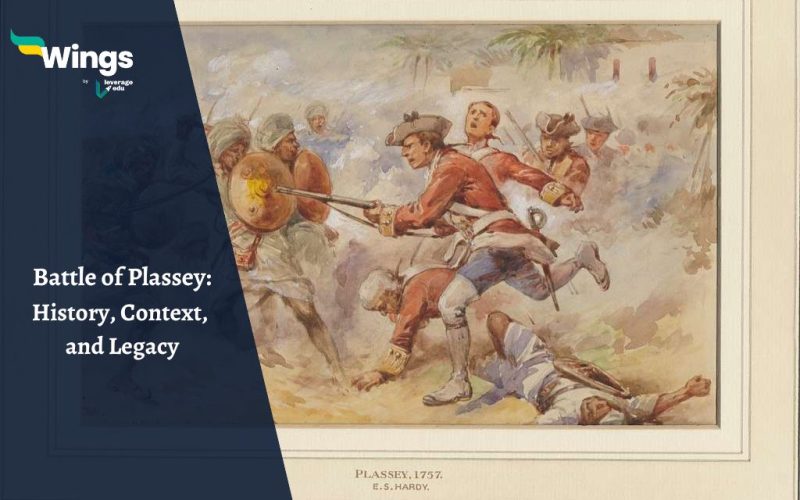The Battle of Plassey, fought on June 23, 1757, was a decisive victory of the British East India Company over the Nawab of Bengal and his French allies. In Indian history, certain battles stand as pivotal turning points that forever alter the course of nations, as they marked the beginning of British rule in India. In this blog, we embark on a journey through time to explore this legendary battle-
What was the Conspiracy on the day of Battle of Plassey?
Table of Contents [show]
The battle took place in the Plassey region of Bengal, about 100 miles north of Calcutta. The British army was led by Robert Clive, while the Nawab’s army was led by Mir Jafar. The Nawab’s army was much larger than the British army, but Clive was able to win the battle through a combination of military strategy and diplomacy.
Also Read – Battle of Buxar: Significance, Causes and Aftermath
The Battle of Plassey was a relatively small battle, with only about 3,000 British troops and 60,000 Nawabi troops engaged. However, the British were better equipped and trained than the Nawabi troops. The British also had the advantage of surprise, as they attacked the Nawabi army during a monsoon storm.
Before the battle, Clive had secretly negotiated with Mir Jafar, one of the Nawab’s most powerful generals. Mir Jafar agreed to betray the Nawab and join forces with the British in exchange for being made the new Nawab of Bengal.
On the day of the battle, Mir Jafar held back his troops, allowing the British to defeat the Nawab’s army. The Nawab was killed in the battle, and Mir Jafar was installed as the new Nawab of Bengal.
The Context
The Battle of Plassey was fought during a period of great upheaval in India. The Mughal Empire was in decline, and regional powers such as the Nawab of Bengal were becoming increasingly powerful. The British and French East India Companies were also competing for influence in India.
The British East India Company had been trading in India for over a century. In the early 1700s, the company began to expand its influence in Bengal by establishing forts and trading posts. The Nawab of Bengal, Siraj-ud-daula, was concerned about the British presence in his territory and ordered the company to demolish its forts.
In 1756, Siraj-ud-daula attacked the British fort at Calcutta. The British surrendered, and the Nawab imprisoned the British garrison in the Black Hole of Calcutta, a small cell where many of the prisoners died of suffocation.
The British responded to the attack on Calcutta by sending a fleet of ships and an army to Bengal. Robert Clive was appointed to lead the British expedition. Clive arrived in Bengal in 1757 and quickly recaptured Calcutta. He then marched inland to Plassey to confront Siraj-ud-daula’s army.
Key Players of the Battle
- Siraj-ud-Daulah: The Nawab of Bengal, a young and audacious ruler, aimed to resist British expansion and protect his territory’s interests.
- Mir Jafar– One of the powerful Commanders-in-Chief of the Nawab army. On the day of the battle, he deceitfully stopped his troops.
- Robert Clive: The astute and daring British military officer who played a pivotal role in the battle. His strategic acumen would shape the destiny of the subcontinent.
Also Read – Battle of Haldighati
Legacy and Consequences
The Battle of Plassey had a profound impact on Indian history. It marked the beginning of British rule in India, which lasted for nearly 200 years. The battle also led to the decline of the Mughal Empire, which had been the dominant power in India for over 200 years.
The British victory at Plassey was due to a number of factors, including the superior training and equipment of the British army, Clive’s military strategy, and Mir Jafar’s betrayal of the Nawab. The battle also showed that the British were willing to use military force to achieve their goals in India.
The Battle of Plassey is a controversial event in Indian history. Some historians argue that the battle was a necessary step in India’s modernization, while others argue that the battle was a disaster that led to centuries of British rule. Regardless of one’s perspective, the Battle of Plassey was a defining moment in Indian history.
FAQ’s
The Battle of Plassey was a decisive victory for the British East India Company against the Nawab of Bengal, Siraj-ud-daula, on June 23, 1757. It was a major turning point in Indian history, as it marked the beginning of British rule in India.
The Battle of Plassey was important because it gave the British East India Company a firm foothold in Bengal, which was the richest and most populous province in India. The British victory also led to the decline of the Mughal Empire and the eventual establishment of British rule over India.
The causes of the Battle of Plassey were complex, but they included the following:
– The rivalry between the British and the French for control of India.
– The ambitions of the British East India Company to expand its trade and influence in India.
– The weakness of the Mughal Empire and the Nawab of Bengal.
– The treachery of Mir Jafar, the commander-in-chief of the Nawab’s army, who conspired with the British to betray Siraj-ud-daula.
For more such interesting and informative topics on Indian History and more, stay tuned to our General Knowledge section. If you want to know more about studying abroad, reach out to our experts on Leverage Edu!
 One app for all your study abroad needs
One app for all your study abroad needs















 45,000+ students trusted us with their dreams. Take the first step today!
45,000+ students trusted us with their dreams. Take the first step today!
